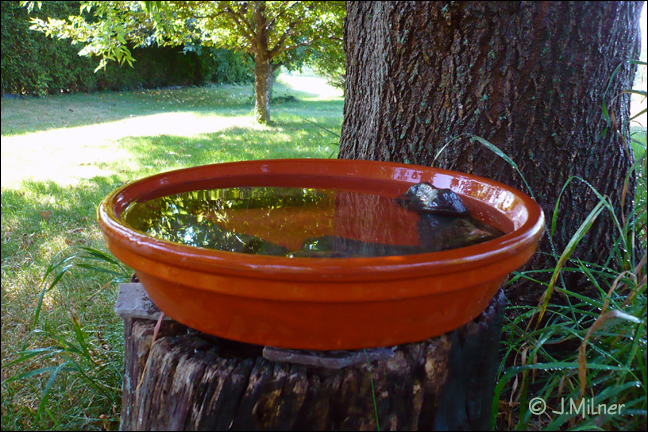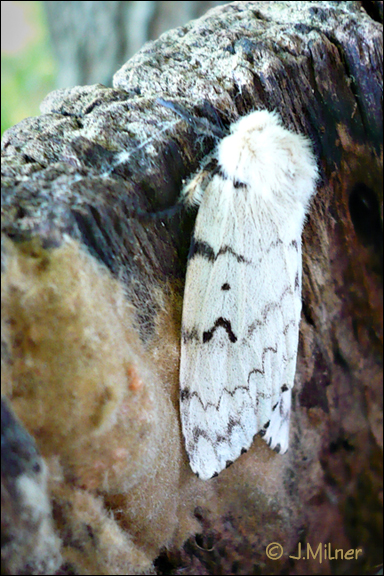 CFN – Have you ever heard of…Gypsy Moths?
CFN – Have you ever heard of…Gypsy Moths?
I had heard of this name before however had never put the visual to the name. The weather in my little corner of the world has been unseasonably hot and our family opted to put out a basin of water out for our visiting feathered friends. No doubt there have been many souls who have appreciated this little refuge to refresh their feathers and quench their thirst. We had an old hollowed out log around which was great to add some height to plate of water and the diameter of the log was small enough to support the diameter of the basin of water. The basin is about three inches deep so we added some rocks so that the birds would have a perch to land and wouldn’t feel intimidated by the depth of the water.

In using such a device it is important to change and clean out the basin at least every other day so that the supply of water is clean and fresh. When removing the basin from the stump for a good cleaning I discovered a white moth in the hollowed out log. I went about my business and replaced the basin on the stump paying careful attention not to disturb the moth. Of course this prompted questions. What kind of moth was this? Is this where it hung out during the day? Would it be there the next time I looked?

When it was time to refresh the water bath again, I checked to see whether our white winged visitor was still there. Sure enough it was, so I googled our winged visitor to get more information. As it turns out this was a female (the male is brown and smaller) gypsy moth. This moth (Lymantria dispar) was introduced into the United States in 1868 by a French Scientist, Leopold Trouvelot living in Massachusetts. Trouvelot imported this species with the intent of breeding a disease resistant hybrid species of silk-spinning caterpillar. Some of the moths escaped, found suitable conditions to live and breed and the rest is history. The gypsy moth is now a major pest (they consume the foliage and needles of trees) of hardwood trees in the Eastern United States.
The first US outbreak occurred in 1889, and by 1987 the gypsy moth had established itself throughout the northeast US, southern Quebec and Ontario. Since 1980, the gypsy moth has defoliated over one million acres (4,000 km²) of forest each year. Gypsy moth larvae prefer oak trees however may feed on many species of trees and shrubs, both hardwood and conifer. The gypsy moth avoids ash trees, butternut, walnut, and catalpa trees to name a few. One of the things that affect the Gypsy Moth is the population of or lack of, of natural predators in the area. Predators of this species include wasps, ground beetles, ants, flies, spiders, chickadees, blue jays, nuthatches, robins, starlings, red-winged blackbirds, squirrels, raccoons and mice. With this expansive list of predators I don’t think we will have to worry about a gypsy moth outbreak in our neck of the woods. A further temperature control factor in Ontario is that over wintering eggs will die should they encounter temperatures below 20°F for three consecutive days. The female often lays her eggs under loose bark in wood piles hence the moth find in our hollowed out log.
.
One little bit of information noted in my investigation was that Gypsy moth hairs are found attached to all life stages of the Gypsy moth. These hairs can cause allergic skin rashes or respiratory reactions.
.
Your commentary is encouraged and always welcome below or to earthmatters@cornwallfreenews.com


As usual, a wonderful story. Thank you Jacqueline.
Thank you for your continued support Stan.
According to http://www.globalchange.umich.edu/globalchange2/current/lectures/deforest/deforest.html
“About one half of the forests that covered the Earth are gone. Each year, another 16 million hectares disappear.” Now I used the word “pest” in the above article because this is how the Gypsy Moth was referenced in the information I read. Kindly take note, that although the Gypsy Moth eats tree foliage, in many cases it does grow back and does not kill the tree. People on the other hand, completely clear cut forests, have little regard for hedge rows or even give conscious thought to the lives that are destroyed in keeping their eye on the singular thought of $$$. Please compare these numbers with that of the Gypsy Moth and ask yourself …who is the real PEST?